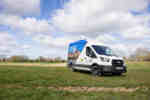Consider that today's Polo is actually three inches longer than the original Mark One Golf, launched almost 30 years ago, and you get a picture of how dimensions have changed and blurred the old sectoral distinctions based on size and comfort levels.
So the new Mark Five Golf, which goes on sale in the UK at the end of January 2004, is 57mm longer than the out-going variant and a massive 15 inches longer than the first Golf. And while dimensions are growing in general across this sector, so the cars win over an increasing share of the old upper-medium sector. Again, the Golf provides a good illustration of this success story.
According to Volkswagen, sales of the Golf have been steadily growing year-on-year. Last year sales reached 72,362, compared to 67,099 in 2001 and 57,359 in 2000.
Since its launch in 1974, more than 22 million Golfs have been sold worldwide in 117 countries and every model brought evolutionary improvements, rather than big headline changes. From what I have seen, the new model is no exception.
The Golf also offers a great illustration of another big shift in recent years – the rise of diesel. Golf diesel sales stood at 2,345 in 1998, a figure which had grown to 34,047 last year and accounted for almost half of all Golf sales. This trend has been causing concern to some, relating to over-supply, but all the Volkswagen dealers I speak to cannot get enough diesel models.
Where Volkswagen might be said to have suffered somewhat is in relation to the legendary GTi badge. Although this is still undoubtedly desirable it has been over-used and therefore effectively watered down. Although a GTi badge no longer carries quite the kudos it once did, Volkswagen says this will change when the new GTI is launched later next year.
What lies behind the overall success of this car is hardly a mystery. There has always been something about the build quality that seeped into public consciousness and the way in which the entire Volkswagen range has been promoted.
On the used market, reliability carries a premium and the typical second-hand buyer fits the profile of the Golf driver like a glove. Never full of gadgets and particularly high-tech innovations, this fact reinforces its appeal on the used market. As CAP Monitor often reflects, exciting toys mean little to the used buyer who is more concerned with practicality, reliability, economy and style.
Although the new Golf is – and looks – significantly updated, with every panel and light changed, along with an all-new interior, it still retains its essential 'Golfness'.
This reflects a continuing policy of evolution rather than revolution and is good news for the fleet market. Any new model inevitably carries a risk of dating the previous version – and potentially depressing values. In the case of new Golf, the overall quality will please the user without damaging returns on the old model for the disposals department.
















Login to comment
Comments
No comments have been made yet.